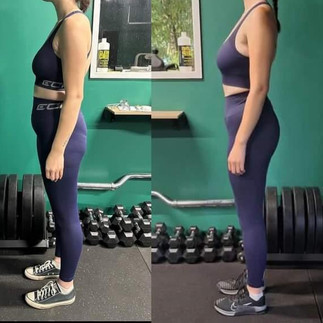Googling ‘How to Train Like a Model’ Got Me Nowhere – Here’s What Actually Works
- kaylamadefitness
- Apr 7
- 4 min read
Updated: Apr 7
In 2015 I was following home workout videos titled "how to train like a VS model" on YouTube with Candice Swanepoel. In 2023 I got to train a model who had appeared in Vogue. Here's how my perspective on "toning" workouts shifted over the eight years between these events.

In 2015, Pinterest searches told me that "toning up" exclusively required light weights, high repetitions, 10+ exercises per session and "clean eating" (which mostly consisted of almonds, chicken breasts and lettuce).
When I joined a gym, I followed Jessica Simpson's Daisy Duke workout program, I also followed Kayla Itsines' guide at one point with a friend, but I felt awkward when it came to anything that involved "hops" or "burpees". Again, weight was still kept light, rest times were short and reps were still high.
I was doing a lot of cardio at this point too and my body did change but it mostly just... shrunk. It didn't gain the shape or definition I had anticipated it would.
These workouts and programs were all missing one key instruction, which I wouldn't learn about until 2016. That instruction was how to progressively challenge my muscles over time so my body would actually start to change shape and "tone up", not just look like a smaller version of my current body.
I didn't dislike my body, but it wasn't until I discovered periodised strength training with a personal trainer that I really started to see the changes I'd wanted while also gaining a sense of confidence and an appreciation for my body I could never have imagined having. Periodised strength training gave me structure, progression, and purpose behind my workouts in a way I’d never experienced before.
It wasn't high reps, light weight, low rest OR heavy weights, low reps, moderate rest times that shaped and refined me, it was both, when paired with one key ingredient: progressive overload.
Progressive overload was the piece that connected all the dots. The reason my body wasn't changing with my previous style of workouts was because I wasn't challenging my muscles in a way that signaled the need to adapt, grow, or strengthen. I wasn't consistently increasing the weight, reps, or difficulty over time. And I wasn't repeating the same exercises for long enough to be able to do this either.
I can't remember a time anymore where I thought lifting "heavy" would make me bulky, I had always been skinny growing up and couldn't really imagine myself looking any other way, but I probably did believe this at one point.
But this belief would have been blown out of the water in the 18-months I worked with my PT.
Or maybe it simply became less of a concern for me, as I became obsessed with the way that lifting "heavy" made me feel. Perhaps even more so than how it was starting to rapidly change how I looked.
Learning to lift "heavy" weights (heavy is relative) made me feel strong, confident and resilient and these feelings improved my life in ways I really can't put into words outside of the gym.
My experiences with my PT eventually lead me to a university qualification in Sport and Recreation (AUT) and starting my own career in the industry.
My exercise programming style now is a strategic mixture of my education, my own training journey and experiences and a deep respect for my client's personal preferences and lifestyles.
It also must be mentioned that it is intertwined with strategic and personalised nutrition which plays a key role in guiding how your body responds to your training.
When I worked with my forementioned client for three months, she was postpartum and looking to return to modelling. She wanted to lose a few kilos, tone up and boost her confidence in front of the camera again. She had also never done any kind of weight training before.
We started with high reps, low weight and shorter rest times as a way to introduce her to unfamiliar movements, starting light with lots of repetition meant she got to practice each movement a lot building movement competency quickly.
Which then allowed us to reduce the number of reps and increase weight gradually in order to increase the challenge.
By the end of the 12-weeks she had lost four kilos, was hip thrusting almost 100kgs and was learning how to Sumo Deadlift with a barbell.
Over the years, my definition of “toning” transformed from feeling limited and uninspiring due to outdated rules to something rooted in strategy, progression, and empowerment.
I learned that true body composition change doesn’t come from chasing soreness or sweating more, it comes from smart programming, thoughtful progression, and a mindset shift around what strength training can look like.
Having worked with countless women since 2018, I can assure you, you don’t need to start with barbells you just need to start with structure, support, and a plan that evolves with you so you can reach your desired destination.
And if you’re still following outdated advice that tells you to lift light, sweat more, to avoid “bulking,” I hope this story shows you there’s another way one that honours your goals while helping you fall in love with the process.
Because body confidence doesn’t come from simply shrinking, or avoiding the weights section due to fear, it comes from stepping into your strength.
If you’re tired of googling "toning workouts" that never seem to deliver, I’d love to help you train with more intention, structure, and confidence. Whether you’re new to lifting, returning after a break or have outgrown your current style of training there’s a starting point that fits you. Visit here to explore your options or enquire.










Comments